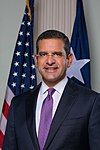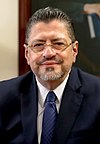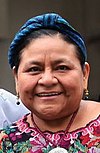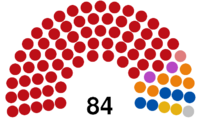User:Sandoria/Sandbox7
Free State of Vanhar | |
|---|---|
| Motto: "Ditat Deus" "God enriches" | |
| Capital and largest city | Aques |
| Official languages | Luzelese Blostlandic Hiyan |
| Religion | 81% Sotirianity
2% Native religions 2% Other faiths |
| Demonym(s) | Vanharian |
| Government | Unitary dominant-party presidential republic |
• President | Sérgio Lindahl |
• Deputy President | Eva Alcantara |
| Legislature | National Legislature of Vanhar |
| Establishment | |
• Independence from Eldmark | 1839 |
• Independence from the Asterian Federative Republic | 1989 |
| Area | |
• | 284,623 km2 (109,894 sq mi) |
| Population | |
• 2022 census | 10,874,498 |
| Currency | Vanharian Real |
| Internet TLD | .vr |
Vanhar (Luzelese: Vánhar; Blostlandic: Vänjer), officially the Free State of Vanhar (Luzelese: Estado Livre de Vánhar; Blostlandic: Fristaten Vänjer), is a sovereign country in central Asteria Superior. It is bordered by the Asterian Federative Republic to the north, Eldmark to the south, and Ardesia to the east. It's capitol and largest city is Aques, other major cities include Hannaholm, Saltes, Branco, De Castro, and Blixtoken. It has a population of 10,874,498 people and covers a total area of 284,623 square kilometers. It is made up of 15 Departments, one of them being the National Department of Aques.
The region of Vanhar was initially settled by Zapoyans, Odavli, and Hiyans for thousands of years. After the discovery of the Asterias by Assim Asteris. Blostlandic settlers arrived in the area and colonized the area as apart of modern-day Eldmark. The region eventually became settled by agricultural settlers from Euclea, the native population slowly began to be pushed back by colonists, the region became known as Vänjer.
After Eldmark declared independence from Blostland, Luzelese-speaking settlers from the Asterian Federative Republic began to settle south into Vänjer. Eventually the Luzelese population grew to become massive and eventually they declared independence from Eldmark as the Republic of Vanhar. Eventually they voted to join the AFR.
During the late 1800s, the Hiyan population and the government of the AFR fought the Hiyan War which saw the killings of much of the Hiyan nation. Afterwards, the discovery of oil in the north and central parts of Vanhar lead to massive rush of settlers into the area. The oil industry became massive and a major part of the AFR's economy.
After the Great Collapse in 1913, the economy of Vanhar became devastated, the 1916 Cervejaria de Poeira, a massive dust storm that destroyed the agriculture in the region as well. During the Great War, the Ardesian State invaded the AFR, Vanhar became a front for the war, the governor of Vanhar, António Lagerfeld, would collaborate with Ardesian functionalists. A resistance led by the socialist Edmundo Esteves would rise up against both Ardesia and the AFR. He was later executed by the AFR government for his rebellion. After the Great War, governor Vicente Rebelo Mata worked on reforms and rebuilding the state.
In the 1980s the economic downturns and military rule in the AFR lead to separatists, known as the Separas, to rise up in Vanhar. In 1989 under Bernardo Erhardsson, the government of Vanhar declared independence from the AFR alongside numerous other states. Afterwards the 1990s became full of turmoil as leftist guerillas persisted, and a peace deal in 1999 lead to the rise of the Broad Liberation Front under Geraldo Saldanha. Since 2000 the government has been ruled by the FAL party since, right-wing guerillas still exist in some parts of the country, many wanting to rejoin the AFR. Today Vanhar is lead by President Sérgio Lindahl, and is a part of the CN, LOPS, OAN, and FNPI.
History
Precolonial
Blostlandic colony
Eldmarsk period
Republic period
AFR statehood
Late 1800s
Early 1900s
Great War
Mid 20th century
- Rebellion and execution of Edmundo Esteves
- Rebelo Mata Governorship
- Military coup

Governorship The first military governor of Vanhar was General Gustavo Anderberg, a native to the state.
- General Henrique Luzilho Governership
- Governor Erhardsson takeover
Independence and 1990s
In 1989 the government of the AFR was collapsing as much of the military became less interested in the government and began to defect. Separas forces were making gains in the region of Vanhar as well. In 1988 Bernado Erhardsson was elected as Governor of Vanhar under promise of reforms, but as the situation in the AFR worsened he began to push for independence. Governor Erdhardsson and the State Legislature declared independence in 1989, along with several other states of the eastern AFR. Vanhar became an official member of the Community of Nations soon afterwards. In 1990 a constitution was created and Erhardsson was made the first President of the Free State of Vanhar, he would form the Vanharian Constitutional Party, based on Rebelismo, the ideology of Rebelo Mata. The Direidors became disbanded after independence, but left-wing forces remained and continued to rebel against Erhardsson.
He would ally with the conservative Social Sotirian Unity party, during his rule he founded many governing institutions, he became a major player in the founding of the Forum for International Paretophone Nations, he would attempt to but ultimately failed to join the North Vehemens Organization in 1993. Erhardsson maintained close relations with his AFR counterpart, Jose Ramos, and helped prosecute Vanharians of the previous military state in the National Truth Tribunal. By 1994 the Esquedor situation worsened after they had captured the city of Kunsla in southeast Vanhar. Many claimed that the country was still under authoritarian rule and AFR influence under Erhardsson. These Esquedors included groups like the Estevista Army of National Liberation, or the EELN, which was the largest of the groups. Many of these leftists groups followed the ideology of Esteves, who became a symbol of the Vanharian left. Throughout the 1990s attempts to quell the rebellion were made by Erhardsson, and in 1996 the Vatenfa massacre commited by the military would doom his election chances.
In the 1996 election the Social Sotirian Unity party took over under Pedro Riveira, who would push for more severe punishment for Esquedor rebels. He would attempt to join the NVO as well during his term, but this also was not seen through. Riveira worked deeper with the AFR to end the conflict, and in 1999 a peace deal was made under the supervision of Jose Ramos, the disarmament of the Esquedors and introduction of former rebels into a peaceful political system instead would end the conflict. Many Esquedors united into various political parties and were eyeing power in the 2000 election.
21st century Vanhar
After the peace deal many left-wing groups united into political parties. In 2000 the Estevist political party known as the Broad Liberation Front under Geraldo Saldanha would win the election with over 55% of the vote.
Under Geraldo Saldanha many workers' rights reforms were pushed, as well as reforms to the subdivisions, completely getting rid of the indigenous regions, claiming they isolated the indigenous population. Saldanha also integrated the Hiyan language into schools and the government. He would pass a law making it mandatory for indigenous representation in regional governments. The FAL would gain a supermajority after uniting with other parties in the 2004 elections, although the opposition and many critics of Saldanha considered the elections to be unfair. In his later terms Saldanha would combat economic downturns and punished banks for failures during the 2005 recession.
Saldanha was succeeded by Tiago Alcantara, who would lose some seats in the 2008 elections but continued with a supermajority. He would open further relations with the Association for International Socialism, while not being and observer of the organization he would often attend meetings. Alcantara would pass a referendum in 2012 that would deepen FAL control of media in the country. Direidor rebels in the northern regions claiming to want to rejoin the AFR sprung up in 2013. Alcantara became adversarial with Tomas Pereira of the AFR and blamed him for the rebels.
Alcantara was succeded by his Deputy Sérgio Lindahl in 2017, Lindahl has opened relations up with NVO nations such as Eldmark, but still continues to work with Chistovodia politically. Under Lindahl reforms such as a tax law that punished loopholes and reforming Vanhar's economic zones.
Geography
Flora and fauna
Government and politics
Political parties
 |
|
Government (68) Broad Liberation Front (67) Indigenous Force (1) Opposition (16) Vanharian Liberal Alliance (6) Social Sotirian Unity (5) Levanta (2) Popular Revolutionary Alternative (2) Independent (1) |
Economy
Demographics
Religion
Ethnicities
Culture
Music
Quisine
Art
Architecture
Clothing
Festivals and holidays
| Logo | Party | Leader(s) | Vanharian National Legislature | Departmental Governorships | Ideology | ||
|---|---|---|---|---|---|---|---|

|
Broad Liberation Front Frente Ampla Libertação |

|
Sérgio Lindahl | 67 / 84
|
13 / 15
|
Estevismo Left-wing nationalism Left-wing populism Sotirian socialism | |

|
Vanharian Liberal Alliance Aliança Liberal Vánharenha |

|
Jorge Olivas Aznar | 6 / 84
|
1 / 15
|
Rebelismo Liberalism | |

|
Social Sotirian Unity Unidade Social Sotiriano |

|
Beatriz Dimas | 5 / 84
|
1 / 15
|
Sotirian democracy Liberal conservatism Civic nationalism | |
| Levanta Levanta |

|
Raúl Busch | 2 / 84
|
0 / 15
|
Right-wing populism Conservatism Nationalism | ||

|
Popular Revolutionary Alternative Alternativa Popular Revolucionária |

|
Félix Noronha | 2 / 84
|
0 / 15
|
Social democracy Progressivism Democratic socialism | |

|
Indigenous Force Força Indígena |

|
Chooli Aguiar | 1 / 84
|
0 / 15
|
Indigenous politics | |



















